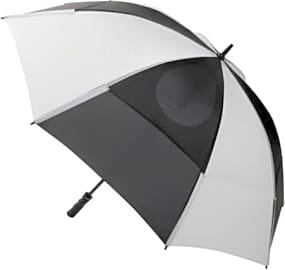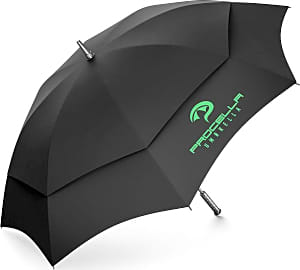The 10 Best Golf Umbrellas

This wiki has been updated 38 times since it was first published in October of 2016. A day on the course can quickly become ruined by a rainstorm, high winds, or sun that is so fierce it makes you too hot and uncomfortable. Luckily, these golf umbrellas are designed to protect you from all the elements, so you can focus on your swing. They are available with generously-sized canopies and come in several styles at a variety of prices to meet most budgets. When users buy our independently chosen editorial recommendations, we may earn commissions to help fund the Wiki.
Editor's Notes
June 27, 2020:
A good golf umbrella should provide protection against the sun's harsh UV rays, the rain, and the wind since any of those elements can throw off your game. For that reason, we looked for durable construction and added features specifically designed to handle these issues. We also aimed to include a good variety of styles, as well as sizes, so both those playing solo or hoping to cover themselves and a friend could find something on this list.
The G4Free Automatic didn't meet our durability standards, as its ribs manage to break in moderate winds, so it lost its spot. In its place came the LifeTek New Yorker FX1, which has strong ribs, and the GustBuster Proseries, which has been tested to stand up to 55 mile-per-hour gusts. The Rainlax Oversize also faced issues in strong winds, often inverting or breaking entirely, so it, too, had to go. We did appreciate the large canopy of the Rainlax Oversize, but fortunately, we have the Heasy Windproof and the Procella Heavy Duty, both of which have massive canopies.
Sun protection is very important during long days on the course, and while some good sunscreen can help a lot, it's nice to be under the shade of a quality umbrella, too. On that note, we added the UV-Blocker UV Protection, with its reflective fabric that is designed to drop the temperature beneath it by up to 15 degrees. We also included the Sport-Brella Versa-Brella because its adaptable design allows you clamp it onto a number of surfaces when you find you need shade, and it can be tilted and swiveled to get that perfect angle.
We didn't want to leave out your clubs, since they're quite the investment, so we brought in the DrizzleStik Flex, which is designed specifically to protect your precious gear from the elements.
Special Honors
Scully & Scully Golf Umbrella The Scully & Scully Golf Umbrella is built to last with an oil-tempered steel frame and wooden handle. Its curved grip should be easy to hang over the back of a cart, and its durable nylon canopy is ready for most weather conditions. Available in three color combinations as well as an all-black model, it's easy to match to most apparel. scullyandscully.com
Weatherman Arnold Palmer 68-inch Classic Golf The bright and multi-colored canopy of the Weatherman Arnold Palmer 68-inch Classic Golf should make it easy for other players to spot you on the course. It's been tested to withstand winds as fast as 55 miles per hour and has a UPF rating of 50+ to protect you from sun damage on bright days. The wrist strap makes it convenient to carry when it's closed, though it may feel heavy at 2.33 pounds. weathermanumbrella.com
A Brief History of Golf
Like the Belgians before them, the Scots were so crazy about the game that the government briefly prohibited playing it.
Before golf came along, the only reliable way to raise your blood pressure and ruin a perfectly good Saturday was to yell at your family for a few hours. Once the game was invented, though, it gave people an excuse to scream at an inanimate object instead.
A version of the sport dates back to 1297 C.E., when the Dutch were known to play a game with sticks and a leather ball. They called this game "kolf," and it soon spread across the surrounding area. It became so popular that it was actually banned in Brussels —and the penalty for playing included having your overcoat confiscated. They didn't mess around, those Belgians.
While kolf continued to be played for a few hundred years, most experts consider modern golf to have originated in Scotland in the 15th century. The Scots introduced the concept of 18 holes, and later created the first rules and the concept of handicapping.
Like the Belgians before them, the Scots were so crazy about the game that the government briefly prohibited playing it. In this case, King James II was worried that golf was actually undermining national security, as he believed people were spending too much time on the links and not enough time at archery practice.
When the Scottish king James VI inherited the British throne in 1603, he brought Scotland's new national pastime with him. From there, the game spread to France, the Americas, and even Africa. Those other countries didn't play with the same fervor that the Scots did, however — at least not at first.
That all changed about halfway through the 19th century. A variety of factors — including the popularity of Sir Walter Scott and improved transportation infrastructure — all coincided to create a wave of interest in Scotland. This in turn boosted tourism, and many who visited the fair country caught the bug and then brought the game back to their homelands.
Golf clubs started cropping up all over the English-speaking world. By the time the Roaring Twenties rolled around, there were several hundred clubs in the United States alone, and the game took off during this time, thanks in part to stars like Bobby Jones. Interest understandably cooled a bit during WWII, but the ensuing postwar economic boom gave rise to millions of people with lots of time and money to spend.
Today, the game is played all over the world, and it's a complete obsession for millions of people who take every opportunity to get in a quick eighteen holes. When they're not playing it, they're watching someone else play it on TV, or talking about the last time they played it, or talking about the next time they'll play it.
It all adds up to just one thing: we need the government to ban it again.
Why You Need a Golf Umbrella
When it comes to golf gear, you may think that too much is never enough. You always need new clubs, maybe a high-tech rangefinder, and of course, multiple flasks.
But do you really need a golf umbrella? Umbrellas hardly seem fun.
That's true — you're not going to get many chuckles out of your umbrella. Even so, they're important pieces of equipment that belong in any serious duffer's bag.
The pole and ribs are usually made of fiberglass, helping to keep the weight down while still being sturdy, and also being unlikely to attract a stray lightning bolt.
Typically, a golf umbrella is larger than a regular umbrella. The pole and ribs are usually made of fiberglass, helping to keep the weight down while still being sturdy, and also being unlikely to attract a stray lightning bolt.
Because the umbrellas are so large, you can shelter multiple people under them, while also protecting your bag and all the gear inside.
They're not just for rainy days, though. Skin cancer is a huge risk for anyone who spends hours in the sun, so giving yourself a place to be shielded from its rays is a smart idea.
So, while having a good golf umbrella might not shave any strokes off your game, it can help extend how long you're able to play. After all, it's always good to stay on the right side of the green — assuming you can even find it, with that stroke of yours.
What to Look For in an Umbrella
There's more involved in buying a golf umbrella than you might expect, so it would behoove you to do a little research before making your decision.
Check to see if it's something that can be hooked up to your bag or cart, or if you'll have to hold it. Obviously, it's more convenient not to support it yourself, but you'll sacrifice some stability as a result, especially in high winds.
Also, if you get one with a vivid design, you can use it to distract other players while they're trying to putt.
If you do have to hold it, examine the handle. You'll need an ergonomic grip, because the last thing you want is to have your hand cramp up mid-stroke because of your umbrella.
They're not all equally big, so examine the dimensions. Larger is usually better, especially if you'll be wanting to fit multiple people under it.
While most have fiberglass poles, that's not always the case. You can find some made of steel, and others made of plastic. Steel is the strongest, but it does have a tendency to give Zeus something to aim at during a storm. Plastic is cheap, but...plastic is cheap.
Consider the fabric while you're at it. Check to see if it's UV-resistant, because it would be awful to get a sunburn while taking shelter from the sun. Some fabrics have special coatings that repel water, while others have been reinforced to resist tears, so choose one that will be best suited for whatever weather you expect to encounter most frequently.
Put some thought into which color you want as well, as the brighter it is, the easier you'll be to see on the course, which makes you less likely to take a Titleist to the dome.
Also, if you get one with a vivid design, you can use it to distract other players while they're trying to putt.















